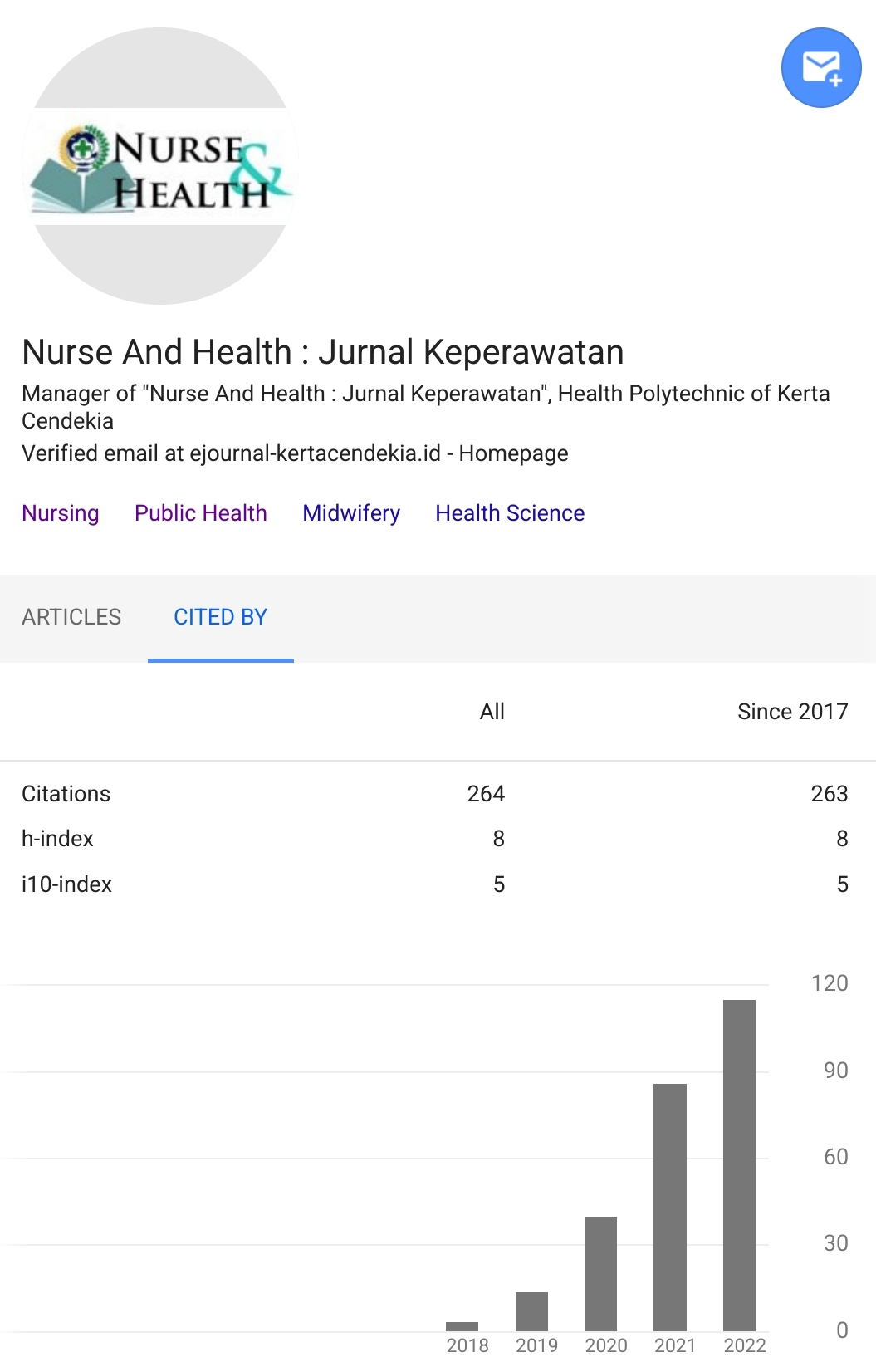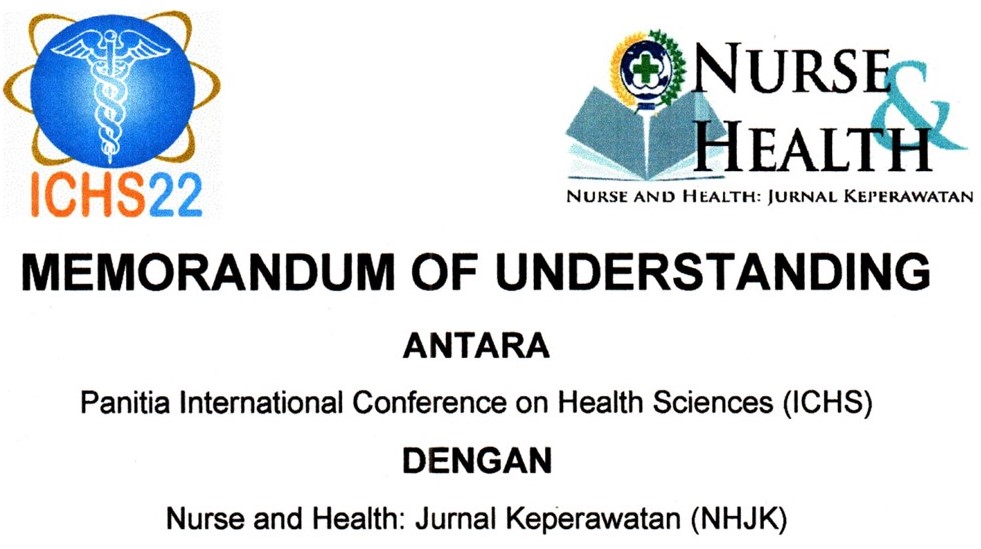THE EFFECT OF BENEFITS, BARRIERS, AND SELF-EFFICACY ON PUBLIC HEALTH PROMOTION BEHAVIOR DURING THE COVID-19 PANDEMIC
Abstract
Background: Pandemic of Covid-19 situation made people to adapt wiht new normal habitually. Health promotion behavior may determine by perceived benefit, barrier, and self-efficacy. Objectives: This research aimed to know the effect of perceived benefit, barrier, and self-efficacy to health promotion behavior in Palembang during pandemic Covid-19. Methods: This study done with cross-sectional design to 183 respondents who lived in Palembang taken by randomized with online questionnaire. The instrument of this study conducted from Pender’s HPM model developed by author. Study result analyzed by SEM-PLS approach to test direct and indirect effects. Results: The results showed that there was not significant effect of self-efficacy to barrier (β= -0.137; p= 0.067) and health promotion behavior (β= -0.026; p= 0.711), but the findings also showed significant effect of self-efficacy to benefit (β= 0.212; p= 0.017), benefit to barrier (β= -0.152; p= 0.046), barrier to health promotion behavior (β= -0.141; p= 0.039), and benefit to health promotion behavior (β= 0.331; p< 0.001). Otherwise, there was also found significant indirect effect of self-efficacy to health promotion behavior by benefit as mediator (β= 0.07; p= 0.026). Overall model give 14.2% to HBP. Conclusion: Perceived benefits and perceived barriers are significant predictors of individual health promotion behavior. Meanwhile, self-efficacy does not have a significant effect. In addition, self-efficacy has a significant influence on perceived benefits and perceived benefits on perceived barriers. Self-efficacy also has an indirect influence on health promotion behavior through perceived benefits as mediatorsDownloads
References
Afro, R. C. (2021). Analisis Faktor Yang Mempengaruhi Kepatuhan Terhadap Protokol Kesehatan Saat Pandemi Covid-19 Pada Masyarakat Jawa Timur: Pendekatan Health Belief Model. Journal of Community Mental Health and Public Policy, 3(1), 1–10. https://doi.org/10.51602/cmhp.v3i1.43 DOI: https://doi.org/10.51602/cmhp.v3i1.43
Akbar, K. R., Wilastiara, E. B., Noviyanti, R., Ardiani, R., & Sudinadji, M. B. (2021). Analisis Perilaku Masyarakat Selama Pandemic Covid-19 Dan New Normal. JIRA: Jurnal Inovasi Dan Riset Akademik, 2(1), 65–78. https://doi.org/10.47387/jira.v2i1.74 DOI: https://doi.org/10.47387/jira.v2i1.74
Al-Hasan, A., Yim, D., & Khuntia, J. (2020). Citizens’ Adherence to COVID-19 mitigation recommendations by the government: A 3-country comparative evaluation using web-based cross-sectional survey data. Journal of Medical Internet Research, 22(8), 1–11. https://doi.org/10.2196/20634 DOI: https://doi.org/10.2196/20634
Alligood, M. R. (2014). Nursing Theorists and Their Work. Missouri: Elseiver.
Ashgar, R. I. (2021). Health-promoting behaviour during the COVID-19 pandemic among Saudi Adults: A cross-sectional study. Journal of Advanced Nursing, 77(8), 3389–3397. https://doi.org/10.1111/jan.14863 DOI: https://doi.org/10.1111/jan.14863
Bernard, C., Tan, A., Slaven, M., Elston, D., Heyland, D. K., & Howard, M. (2020). Exploring patient-reported barriers to advance care planning in family practice. BMC Family Practice, 21(1), 94. https://doi.org/10.1186/s12875-020-01167-0 DOI: https://doi.org/10.1186/s12875-020-01167-0
Faul, F., Erdfelder, E., Buchner, A., & Lang, A.-G. (2009). Statistical power analyses using G*Power 3.1: Tests for correlation and regression analyses. Behavioral Research Methods, 41(4), 1149–1160. https://doi.org/10.3758/BRM.41.4.1149 DOI: https://doi.org/10.3758/BRM.41.4.1149
Faul, F., Erdfelder, E., Lang, A.-G., & Buchner, A. (2007). G*Power 3.1 manual. Behavioral Research Methods, 39(2), 175–191. https://doi.org/10.3758/BF03193146 DOI: https://doi.org/10.3758/BF03193146
Fawcett, J. (2005). Middle-range nursing theories are necessary for the advancement of the discipline. Aquichan, 5(1), 32–43. https://doi.org/10.4090/juee.2008.v2n2.033040 DOI: https://doi.org/10.4090/juee.2008.v2n2.033040
Hallo Palembang. (2021). Palembang Tanggap. Retrieved from Hallopalembang.go.id website: https://www.google.com/url?sa=i&url=https%3A%2F%2Fhallo.palembang.go.id%2Fcovid19%2F&psig=AOvVaw3hLfhDuup_dJAKR2Bertr9&ust=1620466360174000&source=images&cd=vfe&ved=0CA0QjhxqFwoTCPCSu4ait_ACFQAAAAAdAAAAABAD
Haryono, S. (2017). Metode SEM untuk Penelitian Manajemen: AMOS, LISREL, PLS. Jakarta: Luxima Metro Media.
Kuntardjo, N., & Sebong, P. H. (2020). Pola Interaksi Dan Kepatuhan Protokol Kesehatan Oleh Pedagang Di Pasar X Kota Semarang: Studi Kualitatif Eksploratif. Vitasphere, 1(1), 1. https://doi.org/10.24167/vit.v1i1.2974 DOI: https://doi.org/10.24167/vit.v1i1.2974
Lumbanrau, R. E. (2020). Covid-19 Indonesia terus naik: “Orang yang tak taat protokol makin banyak” karena “masyarakat menengah bawah tidak paham”? Retrieved from BBC News Indonesia website: https://www.bbc.com/indonesia/indonesia-53553408
Pakpahan, M., Hutapea, A. D., Siregar, D., Frisca, S., Sitanggang, Y. F., Manurung, E. I., … Hardika, B. D. (2020). Keperawatan Komunitas. Medan: Yayasan Kita Menulis.
Peterson, S. J., & Bredow, T. S. (2013). Middle Range Theories: Application to Nursing Research (3rd ed.). Philadelphia: Wolters Kluwer Health | Lippincott Williams & Wilkins.
Pignatiello, G. A., Irani, E., Tahir, S., Tsivitse, E., & Hickman, R. L. (2020). A psychometric evaluation of the Family Decision-Making Self-Efficacy Scale among surrogate decision-makers of the critically ill. Palliative and Supportive Care, 18(5), 537–543. https://doi.org/10.1017/S1478951519000907 DOI: https://doi.org/10.1017/S1478951519000907
Safitri, E. (2020). Doni Monardo: Warga tak patuh protokol kesehatan karena tak ada sanksi. Retrieved from detik.com website: https://detik.com/berita/d-5197073/doni-monardo-warga-tak-patuh-protokol-kesehatan-karena-tak-ada-sanksi
Satgas Penanganan Covid-19. (2020). Peta Sebaran Covid-19. Retrieved from https://covid19.go.id/peta-sebaran
Supriyati, S., Anggraeny, D. K., Carissa, T. M., Sheila, A. P., Qisthi, S. A., Rianti, M., & Roshan, T. (2021). Preparing new normal: The Health Literacy Assessment on The Covid-19. BKM Journal of Community Medicine and Public Health, 37(1), 27–32. DOI: https://doi.org/10.22146/bkm.63081
Troesch, B., Eggersdorfer, M., Laviano, A., Rolland, Y., Smith, A. D., Warnke, I., … Calder, P. C. (2020). Expert opinion on benefits of long-chain omega-3 fatty acids (DHA and EPA) in aging and clinical nutrition. Nutrients, 12(9), 1–25. https://doi.org/10.3390/nu12092555 DOI: https://doi.org/10.3390/nu12092555
Copyright (c) 2023 Dheni Koerniawan

This work is licensed under a Creative Commons Attribution-NonCommercial 4.0 International License.
Authors who publish with Nurse and Health: Jurnal Keperawatan agree to the following terms:
- Authors retain copyright licensed under a Creative Commons Attribution-NonCommercial 4.0 (CC BY-NC 4.0), which allows others to remix, tweak, and build upon the authors' work non-commercially, and although the others' new works must also acknowledge the authors and be non-commercial, they don't have to license their derivative works on the same terms.
- Authors are permitted and encouraged to post their work online (e.g., in institutional repositories or on their website) prior to and during the submission process, as it can lead to productive exchanges, as well as earlier and greater citation of published work (See The Effect of Open Access). Authors can archive pre-print and post-print or publisher's version/PDF.








_resize1.jpg)















